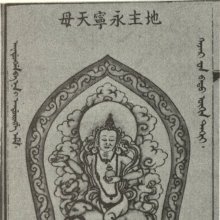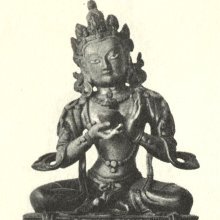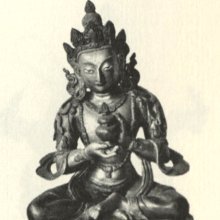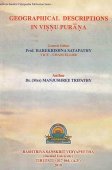Prithivi, Pṛthivī, Prithivī, Prthivī, Prthivi: 32 definitions
Introduction:
Prithivi means something in Buddhism, Pali, Hinduism, Sanskrit, Jainism, Prakrit, the history of ancient India, Marathi, Hindi. If you want to know the exact meaning, history, etymology or English translation of this term then check out the descriptions on this page. Add your comment or reference to a book if you want to contribute to this summary article.
The Sanskrit term Pṛthivī can be transliterated into English as Prthivi or Prithivi, using the IAST transliteration scheme (?).
Images (photo gallery)
In Hinduism
Shaivism (Shaiva philosophy)
Source: Wisdom Library: Kubjikāmata-tantraPṛthivī (पृथिवी):—Sixth of the eight Mātṛs born from the body of Mahimā, according to the Kubjikāmata-tantra. These eight sub-manifestations (mātṛ) are associated with the (element) earth. Pṛthivī evidently refers to the earth. All these eight mātṛs are characterized as carrying a diamond in their hand. They are presided over by the Bhairava Jhaṇṭa and his consort named Aindryā. Mahimā is the seventh of the Eight Mahāmātṛs, residing within the Mātṛcakra (third of the five cakras) and represents the earth.
Source: Wisdom Library: ŚaivismPṛthivī (पृथिवी, “earth”).—The world of the earth is located above the seven pātālas, according to Parākhyatantra 5.61.
The following seven continents (dvīpa) are situated in the earth:
- Jambū-dvīpa,
- Śāka-dvīpa,
- Kuśa-dvīpa,
- Krauñca-dvīpa,
- Śālma-dvīpa,
- Gomeda-dvīpa,
- Puṣkara-dvīpa.
They are collectively known as saptadvīpa. Each continent may contain even more sub-continents within them, are round in shape, and are encircled within seven concentric oceans.
The Parākhyatantra is an old Śaiva-siddhānta tantra dating from before the 10th century.

Shaiva (शैव, śaiva) or Shaivism (śaivism) represents a tradition of Hinduism worshiping Shiva as the supreme being. Closely related to Shaktism, Shaiva literature includes a range of scriptures, including Tantras, while the root of this tradition may be traced back to the ancient Vedas.
Purana and Itihasa (epic history)
Source: Cologne Digital Sanskrit Dictionaries: The Purana IndexPrthivī (प्र्थिवी).—Adopted as daughter by the first king Pṛthu; mother of all creatures, of different janapadas, cities, castes, mountains, rivers, etc.;1 50 (100(1/2) crores, Matsya-purāṇa) crores of yojanas in extent; its bādhavistāra begins with yojanāgra which is one crore in every direction from Meru in the middle; three crores of yojanas in all the four directions; the inside circumference of the earth; the Paryāsa equal to the extent of the nakṣatra maṇḍala;2 comprising seven islands and being tributary to the sons of Svāyambhuva Manu.3
- 1) Matsya-purāṇa 10. 1, 35; Vāyu-purāṇa 42. 78-81; 50. 2-4; 63. 3-4. 74. 30.
- 2) Ib. 124. 12; Vāyu-purāṇa 50. 68-75.
- 3) Matsya-purāṇa 166. 6; 258. 11. Vāyu-purāṇa 33. 4-5.
Pṛthivī (पृथिवी).—Various essences extracted from, by different classes of beings, following Pṛthu's example;1 also Dharā; first milked by Brahmā; in the Vaivasvata epoch, Prthu milked her.2
- 1) Bhāgavata-purāṇa IV. 18. 13-27.
- 2) Brahmāṇḍa-purāṇa II. 20. 1-4; 21. 12; 37. 3, 12-20; III. 3. 34; 5. 79; IV. 2. 11 and 18.
Pṛthivī (पृथिवी) refers to the gross element named “earth” which originates from Gandhatanmātra which originates from Water through its spontaneous self-modification, according to the 10th century Saurapurāṇa: one of the various Upapurāṇas depicting Śaivism.—[...] The rasatanmātra and the rūpatanmātra, being covered up, the differentiated gross water produces the gandhatanmātra, from which again the gross earth (pṛthivī) is produced.
Source: Brill: Śaivism and the Tantric Traditions (itihasa)Pṛthivī (पृथिवी) refers to “this world”, according to the Mahābhārata verse 1.164.9-11.—Accordingly, “The Ikṣvāku kings conquered this world (pṛthivī). Having obtained Vasiṣṭha, the best of sages, as their excellent purohita, those kings performed sacrifices, O descendant of the Kurus. For that Brahmin sage officiated for all those great kings at their sacrifices, O best of the Pāṇḍavas, as Bṛhaspati did for the gods”.

The Purana (पुराण, purāṇas) refers to Sanskrit literature preserving ancient India’s vast cultural history, including historical legends, religious ceremonies, various arts and sciences. The eighteen mahapuranas total over 400,000 shlokas (metrical couplets) and date to at least several centuries BCE.
Pancaratra (worship of Nārāyaṇa)
Source: Wisdom Library: PāñcarātraPṛthivī (पृथिवी) refers to an aspect of nṛsiṃha (‘man-lion’), according to the Vihagendra-saṃhitā 4.17, which mentions seventy-four forms (inlcuding twenty forms of vyūha). He is also known as Pṛthivīnṛsiṃha or Pṛthivīnarasiṃha. Nṛsiṃha is a Tantric deity and refers to the furious (ugra) incarnation of Viṣṇu.
The 15th-century Vihagendra-saṃhīta is a canonical text of the Pāñcarātra corpus and, in twenty-four chapters, deals primarely with meditation on mantras and sacrificial oblations.

Pancaratra (पाञ्चरात्र, pāñcarātra) represents a tradition of Hinduism where Narayana is revered and worshipped. Closeley related to Vaishnavism, the Pancaratra literature includes various Agamas and tantras incorporating many Vaishnava philosophies.
Ayurveda (science of life)
Nighantu (Synonyms and Characteristics of Drugs and technical terms)
Source: Wisdom Library: Raj NighantuPṛthivī (पृथिवी) refers to “earth” and is mentioned in a list of 53 synonyms for dharaṇi (“earth”), according to the second chapter (dharaṇyādi-varga) of the 13th-century Raj Nighantu or Rājanighaṇṭu (an Ayurvedic encyclopedia). The Dharaṇyādi-varga covers the lands, soil [viz., Pṛthivī], mountains, jungles and vegetation’s relations between trees and plants and substances, with their various kinds.

Āyurveda (आयुर्वेद, ayurveda) is a branch of Indian science dealing with medicine, herbalism, taxology, anatomy, surgery, alchemy and related topics. Traditional practice of Āyurveda in ancient India dates back to at least the first millenium BC. Literature is commonly written in Sanskrit using various poetic metres.
Vaisheshika (school of philosophy)
Source: Shodhganga: A study of Nyāya-vaiśeṣika categories (vaisesika)Pṛthivī (पृथिवी, “earth”) refers to one of the nine substances (dravya) according to the Nyāya-Vaiśeṣika school of philosophy (cf. Vaiśeṣikasūtra 1.1.5, Saptapadārthī, Tarkabhāṣā and Bhāṣāpariccheda). Pṛthivī is the first substance mentioned in all the lists of substance. Annaṃbhaṭṭa has defined earth as that where smell exists gandhavatī pṛthivī. He has not however, explained the definition elaborately. But here the suffix vat must mean to exist in the relation of inherence (samavāya). Otherwise the definition will be over-pervasive to time and space. For smell is related with time through temporal (kālika) relation and with space through spatial (daiśika) relation. That is why, here the inherent relation is to be accepted. Hence, Viśvanātha has clarified the definition of earth (pṛthivī) as the inherent cause of smell or odour.
Kaṇāda (Vaiśeṣikasūtra 2.1.1) states that earth (pṛthivī) has four qualities—colour, taste, odour and touch. Praśastapāda states in his Bhāṣya (Praśastapādabhāṣya) that earth has colour, taste, smell, touch, number, magnitude, separation, conjunction, disjunction, remoteness, proximity, weight, fluidity and velocity. Earth (pṛthivī) has many kinds of colour like whiteness, blackness etc. (cf. Nyāyasiddhāntamuktāvalī) There is six kinds of taste, viz., sweet, sour, salt, bitter, pungent and astringent. Earth has two kinds of smell, good and bad. Earth also possesses the quality of neither hot nor cold and touch which is generated by the action of fire (cf. Praśastapādabhāṣya).
Earth (pṛthivī) is mainly divided into two kinds:—nitya (eternal) and anitya (noneternal). Śivāditya, Praśastapāda, Viśvanātha etc. also uphold the same view. Nitya means that which is not counter positive (pratiyogī) of destruction. That means eternal is that which is not destroyed. Non-eternal (anitya) is the opposite, i.e., it is the counter positive of destruction. That non-eternal is that which can be destroyed. That eternal is that which is not the counter positive of both prior non-existence and non-existence pertaining to destruction. Non-eternal is the counter positive of both these types of non-existence. The atoms of earth are eternal while things produced from earth-atoms are noneternal. Non-eternal things are composed of parts.
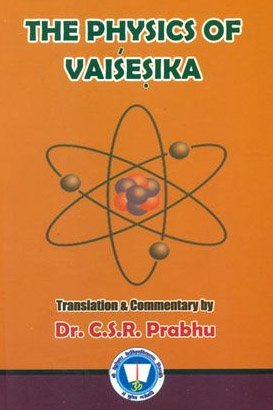
Vaisheshika (वैशेषिक, vaiśeṣika) refers to a school of orthodox Hindu philosophy (astika), drawing its subject-matter from the Upanishads. Vaisheshika deals with subjects such as logic, epistemology, philosophy and expounds concepts similar to Buddhism in nature
Yoga (school of philosophy)
Source: ORA: Amanaska (king of all yogas): A Critical Edition and Annotated Translation by Jason BirchPṛthivī (पृथिवी) or Pṛthivītattva refers to the “(elemental power of) earth” and as one of the “five elemental powers”, represents one of the various signs and paranormal powers (siddhi) experienced by the Yoga practicioner, according to the Amanaska Yoga treatise (presented in the form of a dialogue between Īśvara and Vāmadeva).—The last fifty-two verses of the Amanaska’s first chapter describe a temporal sequence of psychosomatic signs and paranormal powers (siddhi) brought about by absorption (laya). In the Amanaska, The five elemental powers are, [e.g., earth (pṛthivī-tattva )], [...].

Yoga is originally considered a branch of Hindu philosophy (astika), but both ancient and modern Yoga combine the physical, mental and spiritual. Yoga teaches various physical techniques also known as āsanas (postures), used for various purposes (eg., meditation, contemplation, relaxation).
General definition (in Hinduism)
Source: Wisdom Library: ĀraṇyakaPṛthivī (पृथिवी, “earth”) refers to one of the lokapañcaka (fivefold worlds), defined in the Taittirīya-āraṇyaka 7.7.1. The lokapañcaka, and other such fivefold divisions, are associated with the elemental aspect (adhibhūta) of the three-fold division of reality (adhibhūta, adhidaiva and adhyātma) which attempts to explain the phenomenal nature of the universe. Adhibhūta denotes all that belongs to the material or elemental creation.
The Taittirīya-āraṇyaka is associated with the Kṛṣṇa-yajurveda and dates from at least the 6th century BCE. It is composed of 10 chapters and discusses vedic rituals and sacrifices (such as the mahāyajña) but also includes the Taittirīya-upaniṣad and the Mahānārāyaṇa-upaniṣad.
In Buddhism
Mahayana (major branch of Buddhism)
Source: Wisdom Library: Maha Prajnaparamita Sastra1) Pṛthivī (पृथिवी) refers to the element “earth”, according to the 2nd century Mahāprajñāpāramitāśāstra chapter XLIX. Accordingly, “the earth (pṛthivī) itself is very extensive (vistīrṇa), it supports the ten thousand things and is very solid (dṛḍha). This is why the Buddha says here that in order to know fully the number of subtle atoms (paramāṇu) contained in the earth (pṛthivī) and the Mount Sumerus of the trisāhasramahāsāhasralokadhātu and in order to know the respective part beings hold in regard to their actions, it is necessary to practice the perfection of wisdom”.
By cultivating the Prajñāpāramitā, this great earth (mahāpṛthivī) is reduced to its subtle atoms (paramāṇu). Because the earth element (pṛthivī) possesses color (rūpa), odor (gandha), taste (rasa) and touch (spraṣṭavya), it is heavy (guru) and does not have activity (kriyā) on its own.—Because the water (ap-) element has no taste (rasa), it is superior to earth (pṛthivī) by means of its movement (calana).—Because the fire (tejas) element has neither odor (gandha) nor taste (rasa), it is superior to water in its power (prabhāva).—Because the wind (vāyu) element is neither visible (rūpa) nor has it any taste (rasa) or touch (spraṣṭavya), it is superior to fire by means of its movement (īraṇa).—The mind (citta) which has none of these four things [color, taste, smell and touch] has a still greater power.
2) Pṛthivī (पृथिवी, “earth”) according to a note at chapter 51.—According to the canonical sūtras (Dīgha; Kośavyākhyā), the earth (pṛthivī) rests upon the water (udaka) or Circle of waters (abmaṇḍala); the water or Circle of waters rests on wind (vāyu); the wind rests on space (ākāśa); space does not rest upon anything.—In this summary, there is no mention of gold (kañcana) or diamond (vajra). Later scholasticism, particularly that of the Sarvāstivādins (Kośa; Kośabhāṣya) gives more details: [...] The earth of gold (kāñcanamayī supports the earth (pṛthivī), the universe of four continents encircled by the cakravāda which gives it the shape of a wheel.
Source: academia.edu: A Study and Translation of the GaganagañjaparipṛcchāDhātu (धातु) refers to the “(realm of) earth”, according to the Gaganagañjaparipṛcchā: the eighth chapter of the Mahāsaṃnipāta (a collection of Mahāyāna Buddhist Sūtras).—Accordingly, “[...] Having entered into the way of the realm of the dharma, he knows the fact that [...] there is no duality of the realm of aggregates and the realm of the dharma; why?—because the realm of aggregates has the nature of the realm of the dharma; there is no duality of the realm of earth (pṛthivī-dhātu), water, fire or wind and the realm of the dharma; why?—because the earth, water, fire or wind has the nature of the realm of the dharma; [...]”.

Mahayana (महायान, mahāyāna) is a major branch of Buddhism focusing on the path of a Bodhisattva (spiritual aspirants/ enlightened beings). Extant literature is vast and primarely composed in the Sanskrit language. There are many sūtras of which some of the earliest are the various Prajñāpāramitā sūtras.
Tibetan Buddhism (Vajrayana or tantric Buddhism)
Source: Wisdom Library: Tibetan Buddhism1) Pṛthivī (पृथिवी) refers to a group of deities summoned by the Yamāntaka-mantra and mentioned as attending the teachings in the 6th century Mañjuśrīmūlakalpa: one of the largest Kriyā Tantras devoted to Mañjuśrī (the Bodhisattva of wisdom) representing an encyclopedia of knowledge primarily concerned with ritualistic elements in Buddhism. The teachings in this text originate from Mañjuśrī and were taught to and by Buddha Śākyamuni in the presence of a large audience (including Pṛthivī).
2) Pṛthivī (पृथिवी) is the name of a Rāśi (zodiac sign) mentioned as attending the teachings in the 6th century Mañjuśrīmūlakalpa.

Tibetan Buddhism includes schools such as Nyingma, Kadampa, Kagyu and Gelug. Their primary canon of literature is divided in two broad categories: The Kangyur, which consists of Buddha’s words, and the Tengyur, which includes commentaries from various sources. Esotericism and tantra techniques (vajrayāna) are collected indepently.
In Jainism
General definition (in Jainism)
Source: archive.org: Trisastisalakapurusacaritra1) Pṛthivī (पृथिवी) refers to one of the eight Dikkumārīs living on the western Rucaka mountains (in the Rucakadvīpa continent), according to chapter 1.2 [ādīśvara-caritra] of Hemacandra’s 11th century Triṣaṣṭiśalākāpuruṣacaritra: an ancient Sanskrit epic poem narrating the history and legends of sixty-three illustrious persons in Jainism.—Accordingly, “[...] Eight Dikkumārīs [viz., Pṛthivī] also, living on the west Rucaka Mountains, came in haste, as if outstripping each other from devotion. Having bowed to the Jina and the Jina’s mother and having announced themselves as before, they stood behind, holding palm-leaf fans, singing. [...].”.
Note: In the continent Rucakadvīpa is a circular mountain-ranges Rucaka. On this in the four directions are 4 temples, and on both sides of each temple are 4 mountain peaks, making 8 peaks in each direction. Each peak is inhabited by a Dikkumārī [viz., Pṛthivī].—(cf. ‘Die Kosmographie der Inder’ pp. 257f).
2) Pṛthivī (पृथिवी) refers to one of the two wifes of king Rudra from Dvārakā, according to chapter 4.3 [vimalanātha-caritra].—Accordingly:—“Now in Bharatakṣetra in the city Dvārakā there was a king, Rudra, deep as the ocean. He had two wives, Suprabhā and Pṛthivī, like beauty and the earth in person, charming with a wealth of beauty and virtues. Nandisumitra’s soul fell from Anuttaravimāna and descended into Queen Suprabhā’s womb. [...] Dhanamitra’s soul fell from the heaven Acyuta and was generated in Queen Pṛthivī’s womb like a lotus in a pool. [...]”.
3) Pṛthivī (पृथिवी) is the wife of Purandara, son of Himacūlā and king Vijaya, according to the Jain Ramayana and chapter 7.4 [Rāma and Lakṣmaṇa].—Accordingly, “When King Vijaya heard that Vajrabāhu had become a mendicant, he became disgusted with existence at the thought, ‘He, though a boy, is better than I’. Then Vijaya installed his son, Purandara, in his kingdom and took the vow under Muni Nirvāṇamoha. Purandara put on the throne his son, Kīrtidhara, borne by Pṛthivī, and became an ascetic under the sage, Kṣemaṅkara. Then King Kīrtidhara enjoyed pleasures of the senses with his wife Sahadevī, like Purandara with Paulomī. [...]”.
Source: Encyclopedia of Jainism: Tattvartha Sutra 2: the Category of the livingPṛthivī (पृथिवी, “earth”) refers to one of the five types of immobile beings (sthāvara), according to the 2nd-century Tattvārthasūtra 2.13. The sthāvara is a type of empirical (saṃsārī) soul, or sentient (jīva). The state of empirical souls due to the rise of ‘stationery-body-making karma’/ sthāvara-nāmakarma, having only one type of sense organ namely body and which cannot move around freely are called with stationery bodies (sthāvara), eg., pṛthivī.
What is the meaning of earth (pṛthivī)? The crust of the earth having hardness as its own nature but no consciousness is called earth. What is meant by earth-bodied living beings? These are the living beings that have earth as their body. How many types of earth are there? There are four types of earth namely earth, earth-bodied, life in earth body and life tending towards an earth body.

Jainism is an Indian religion of Dharma whose doctrine revolves around harmlessness (ahimsa) towards every living being. The two major branches (Digambara and Svetambara) of Jainism stimulate self-control (or, shramana, ‘self-reliance’) and spiritual development through a path of peace for the soul to progess to the ultimate goal.
India history and geography
Source: Cologne Digital Sanskrit Dictionaries: Indian Epigraphical GlossaryPṛthivī.—cf. Prakrit sava-puṭhaviyaṃ (CII, Vol. I, p. 87, text line 7); used to indicate the dominions of the Maurya emperor Aśoka, versions other than Dhauli (Rock Edict V) having sarvatra vijite (i. e. ‘everywhere within the dominions’) in its place. Cf. Jambudvīpa. Note: pṛthivī is defined in the “Indian epigraphical glossary” as it can be found on ancient inscriptions commonly written in Sanskrit, Prakrit or Dravidian languages.

The history of India traces the identification of countries, villages, towns and other regions of India, as well as mythology, zoology, royal dynasties, rulers, tribes, local festivities and traditions and regional languages. Ancient India enjoyed religious freedom and encourages the path of Dharma, a concept common to Buddhism, Hinduism, and Jainism.
Languages of India and abroad
Marathi-English dictionary
Source: DDSA: The Molesworth Marathi and English Dictionarypṛthivī (पृथिवी).—f S pṛthvī f (S) The earth. 2 Earth considered as one of the five elements. catussamudravalayāṅkitapṛthvī The sea-girt earth.
Source: DDSA: The Aryabhusan school dictionary, Marathi-Englishpṛthivī (पृथिवी).—f pṛthvī f The earth.
Marathi is an Indo-European language having over 70 million native speakers people in (predominantly) Maharashtra India. Marathi, like many other Indo-Aryan languages, evolved from early forms of Prakrit, which itself is a subset of Sanskrit, one of the most ancient languages of the world.
Sanskrit dictionary
Source: DDSA: The practical Sanskrit-English dictionaryPṛthivī (पृथिवी).—[cf. Uṇādi-sūtra 1.184]
1) The earth; (sometimes written pṛthivi also). पृथिव्यां त्रीणि रत्नानि जलमन्नं सुभाषितम् (pṛthivyāṃ trīṇi ratnāni jalamannaṃ subhāṣitam).
2) Ground, soil.
3) The earth considered as one of the nine substances or five primary elements.
Source: Cologne Digital Sanskrit Dictionaries: Edgerton Buddhist Hybrid Sanskrit DictionaryPṛthivī (पृथिवी).—or Pṛthvī, name of a devakumārikā in the northern quarter: Pṛthivī Padumāvatī Mahāvastu iii.309.8 (verse) = Pṛthvī Padmāvatī tathā Lalitavistara 391.3; note how Lalitavistara San- skritizes and then patches the meter! Both without v.l.
Source: Cologne Digital Sanskrit Dictionaries: Shabda-Sagara Sanskrit-English DictionaryPṛthivi (पृथिवि).—f.
(-viḥ) The earth: see the next.
--- OR ---
Pṛthivī (पृथिवी).—f. (-vī) The earth. E. prath to be famous, Unadi aff. ṣivan, fem. aff. ṅīp, and the vowel substituted for the semi-vowel; also with the anti-penultimate vowel changed to a, pṛthavī; or dropped altogether, pṛthvī; or without the fem. aff. pṛthivi .
Source: Cologne Digital Sanskrit Dictionaries: Benfey Sanskrit-English DictionaryPṛthivī (पृथिवी).—i. e. pṛthvī, f. of pṛthu. 1. The earth personified, [Mānavadharmaśāstra] 2, 225. 2. Earth as an element, [Prabodhacandrodaya, (ed. Brockhaus.)] 27, 19.
Source: Cologne Digital Sanskrit Dictionaries: Cappeller Sanskrit-English DictionaryPṛthivī (पृथिवी).—[feminine] the earth (lit. the wide one, often personif.); land, country, realm.
Source: Cologne Digital Sanskrit Dictionaries: Monier-Williams Sanskrit-English Dictionary1) Pṛthivi (पृथिवि):—[from pṛth] f. = vī.
2) Pṛthivī (पृथिवी):—[from pṛth] f. (= pṛthvī f. of pṛthu) the earth or wide world (‘the broad and extended One’, personified as devī and often invoked together with the sky cf. 3. div and dyāvā-pṛthivī, [Religious Thought and Life in India 182]; according to, [Viṣṇu-purāṇa] daughter of pṛthu; the Veda makes 3 earths, one called bhūmi, inhabited by men, and 2 under it; there is also an earth between the world of men and the circumambient ocean [Śatapatha-brāhmaṇa] and one extending through the 3 worlds [Naighaṇṭuka, commented on by Yāska]), [Ṛg-veda] etc. etc.
3) [v.s. ...] land, ground, soil, [ib.]
4) [v.s. ...] earth regarded as one of the elements, [Prabodha-candrodaya; Suśruta]
5) [v.s. ...] = antarikṣa, [Naighaṇṭuka, commented on by Yāska i, 3]
Source: Cologne Digital Sanskrit Dictionaries: Yates Sanskrit-English Dictionary1) Pṛthivi (पृथिवि):—(viḥ) 2. f. The earth.
2) Pṛthivī (पृथिवी):—(vī) 3. f. The earth.
Source: DDSA: Paia-sadda-mahannavo; a comprehensive Prakrit Hindi dictionary (S)Pṛthivī (पृथिवी) in the Sanskrit language is related to the Prakrit words: Pahuvī, Puḍhavī, Puhai, Puhaī.
[Sanskrit to German]
Sanskrit, also spelled संस्कृतम् (saṃskṛtam), is an ancient language of India commonly seen as the grandmother of the Indo-European language family (even English!). Closely allied with Prakrit and Pali, Sanskrit is more exhaustive in both grammar and terms and has the most extensive collection of literature in the world, greatly surpassing its sister-languages Greek and Latin.
Hindi dictionary
Source: DDSA: A practical Hindi-English dictionaryPṛthivī (पृथिवी):—(nf) see [pṛthvī].
...
Kannada-English dictionary
Source: Alar: Kannada-English corpusPṛthivi (ಪೃಥಿವಿ):—[noun] = ಪೃಥ್ವಿ [prithvi].
Kannada is a Dravidian language (as opposed to the Indo-European language family) mainly spoken in the southwestern region of India.
Nepali dictionary
Source: unoes: Nepali-English DictionaryPṛthivī (पृथिवी):—n. → पृथ्वी [pṛthvī]
Nepali is the primary language of the Nepalese people counting almost 20 million native speakers. The country of Nepal is situated in the Himalaya mountain range to the north of India.
See also (Relevant definitions)
Starts with (+56): Parthivagni, Prithivibhaga, Prithivibhrit, Prithivibhuj, Prithivibhuja, Prithivibhujamga, Prithivicakra, Prithivicala, Prithivicandra, Prithivicarin, Prithivicarini, Prithivichala, Prithivicharin, Prithivida, Prithividandapala, Prithividandapalata, Prithividevi, Prithividhara, Prithividharana, Prithividhatu.
Ends with: Bhaktidyavaprithivi, Divasprithivi, Dyavaprithivi, Mahaprithivi.
Full-text (+352): Prithivitva, Prithavi, Prithivimjaya, Dyavaprithivi, Prithivishakra, Prithiviloka, Prithivitala, Prithivikshit, Prathivi, Prithvi, Prithivishad, Prithivimdada, Prithivipala, Prithivibhuj, Prithiviruha, Prithivimaya, Prithivimant, Prithivimandala, Pudhavi, Prithivipati.
Relevant text
Search found 126 books and stories containing Prithivi, Pṛthivī, Prithivī, Prthivī, Prthivi, Pṛthivi, Prirhivi, Pṛrhivi, Prrhivi; (plurals include: Prithivis, Pṛthivīs, Prithivīs, Prthivīs, Prthivis, Pṛthivis, Prirhivis, Pṛrhivis, Prrhivis). You can also click to the full overview containing English textual excerpts. Below are direct links for the most relevant articles:
Women in the Atharva-veda Samhita (by Pranab Jyoti Kalita)
18. Goddess Pṛthivī < [Chapter 4 - Female Deities and the Glorification of Women in the Atharvaveda]
3. Woman as a Mother < [Chapter 3 - The Familial and Social Life of Women in the Atharvaveda]
3. Goddess Asunīti < [Chapter 4 - Female Deities and the Glorification of Women in the Atharvaveda]
Rig Veda (translation and commentary) (by H. H. Wilson)
Shrimad Bhagavad-gita (by Narayana Gosvami)
Verse 1.19 < [Chapter 1 - Sainya-Darśana (Observing the Armies)]
Verses 1.17-18 < [Chapter 1 - Sainya-Darśana (Observing the Armies)]
Verse 1.2 < [Chapter 1 - Sainya-Darśana (Observing the Armies)]
Garga Samhita (English) (by Danavir Goswami)
Verse 5.2.5 < [Chapter 2 - The Killing of Keśī]
Verses 4.1.37-38 < [Chapter 1 - The Story of the Personified Vedas]
Tattvartha Sutra (with commentary) (by Vijay K. Jain)
Verse 2.13 - One-sensed beings (sthāvara) < [Chapter 2 - Category of the Living]
Verse 4.12 - The subclasses of the stellar beings (jyotiṣka-deva) < [Chapter 4 - The Celestial Beings]
Verse 5.3 - The souls also are substances < [Chapter 5 - The Non-living Substances]
Vaisheshika-sutra with Commentary (by Nandalal Sinha)
Sūtra 8.2.5 (The Sense of Smell is constituted by the element of Earth) < [Chapter 2 - Of Doubly Presentative Cognition]
Sūtra 5.2.12 (Causes of conflagration, tempest, etc.) < [Chapter 2 - Of Non-volitional Action]
Sūtra 7.1.2 (What attributes are non-eternal) < [Chapter 1 - Of Colour, Taste, Smell, and Touch, and Magnitude]
Related products
